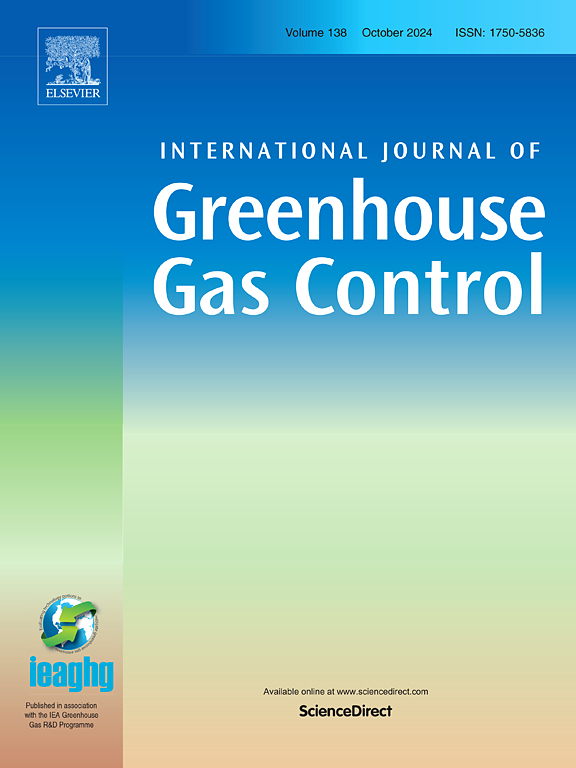利用机器学习地震断层属性降低二氧化碳储存覆盖层和盖层的风险
IF 5.2
3区 工程技术
Q2 ENERGY & FUELS
International Journal of Greenhouse Gas Control
Pub Date : 2025-09-18
DOI:10.1016/j.ijggc.2025.104471
引用次数: 0
摘要
断层和裂缝的几何形状、密度和分布在评估和减轻沉积盆地(特别是含盐含水层)潜在CO 2储存地点相关风险方面发挥着关键作用。为了增强三维地震数据的故障检测,我们开发、训练并部署了一种轻量级的机器学习分割算法。这种深度学习模型在合成地震数据上进行训练,生成断层评分——像素级分类,范围从0到1,其中越高的值表明结构不连续的可能性越大。这些断层分数用于导出断层密度属性,该属性总结了沿地震剖面的预期断层网分布。我们的工作流程计算效率高,为解释人员提供了对断层横向和垂直分布的宝贵见解。我们将这种方法应用到挪威Smeaheia地区的三维地震调查中,该地区覆盖了N-S走向的Vette断层和Øygarden断层复合体的部分(ØFC)。在储层以及盖层和上覆层进行了断层测绘。探测到的Draupne组(该地区假定的盖层单元)顶部的断层模式和top Cromer Knoll组的断层模式与人工解释的结果吻合得很好。此外,在深部地壳ØFC下盘,我们发现了延伸到海底的断层,这表明盖层内可能存在不可忽略的断层密度。我们的结果与三维方差和三维相似地震属性进行了比较,进一步验证了我们方法的有效性。本文章由计算机程序翻译,如有差异,请以英文原文为准。
De-risking overburden and caprocks for CO2 storage using machine-learning seismic fault attributes
Fault and fracture geometries, densities, and distributions play a critical role in assessing and mitigating risks associated with potential CO₂ storage sites in sedimentary basins, particularly saline aquifers. To enhance fault detection in 3D seismic data, we have developed, trained, and deployed a lightweight machine learning segmentation algorithm. This deep learning model, trained on synthetic seismic data, generates fault scores—pixel-scale classifications ranging from 0 to 1—where higher values indicate a greater likelihood of structural discontinuities. These fault scores are used to derive a fault density attribute, which summarizes the expected fault network distribution along seismic sections. Our workflow is computationally efficient and provides interpreters with valuable insight into the lateral and vertical distribution of faults. We apply this methodology to a 3D seismic survey of the Smeaheia area, Norway, covering the N-S trending Vette Fault and sections of the Øygarden Fault Complex (ØFC). Fault mapping was conducted at the reservoir level, as well as in the caprock and overburden. The detected fault patterns at the top of the Draupne Formation, the presumed caprock unit in the region, and fault pattern at the Top Cromer Knoll Group, align well with manual interpretations. Additionally, in the footwall of the deep-crustal ØFC, we identify faults extending to the seafloor, suggesting that a non-negligible fault density may be present within the caprock. Our results are compared with 3D variance and 3D semblance seismic attributes, further validating the efficacy of our approach.
求助全文
通过发布文献求助,成功后即可免费获取论文全文。
去求助
来源期刊
CiteScore
9.20
自引率
10.30%
发文量
199
审稿时长
4.8 months
期刊介绍:
The International Journal of Greenhouse Gas Control is a peer reviewed journal focusing on scientific and engineering developments in greenhouse gas control through capture and storage at large stationary emitters in the power sector and in other major resource, manufacturing and production industries. The Journal covers all greenhouse gas emissions within the power and industrial sectors, and comprises both technical and non-technical related literature in one volume. Original research, review and comments papers are included.

 求助内容:
求助内容: 应助结果提醒方式:
应助结果提醒方式:


